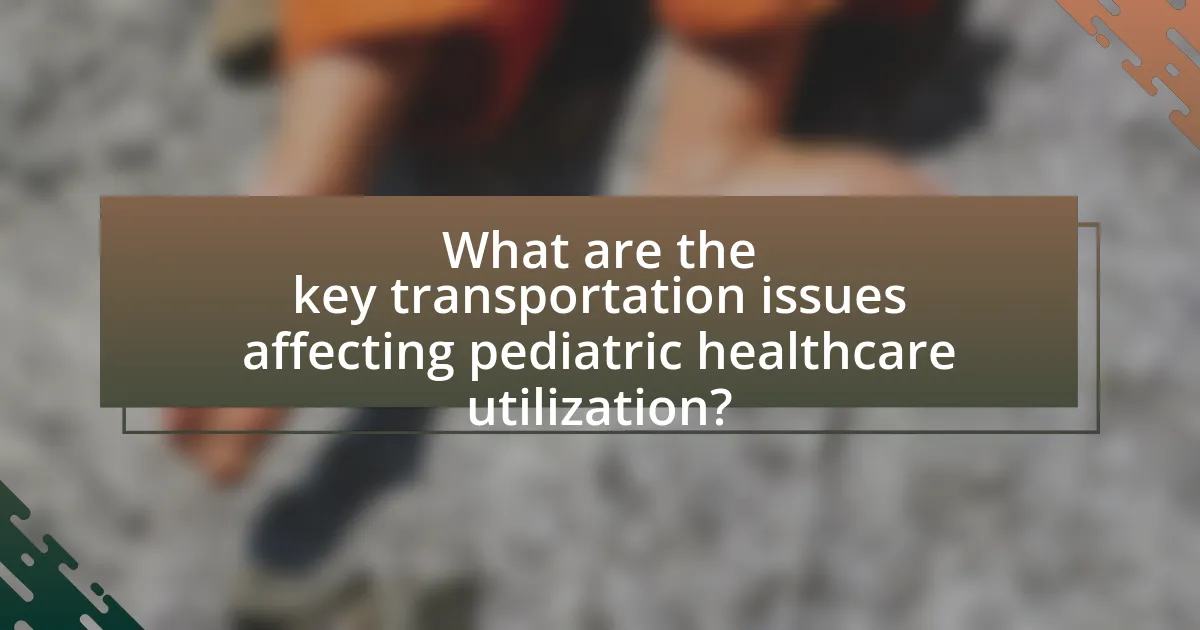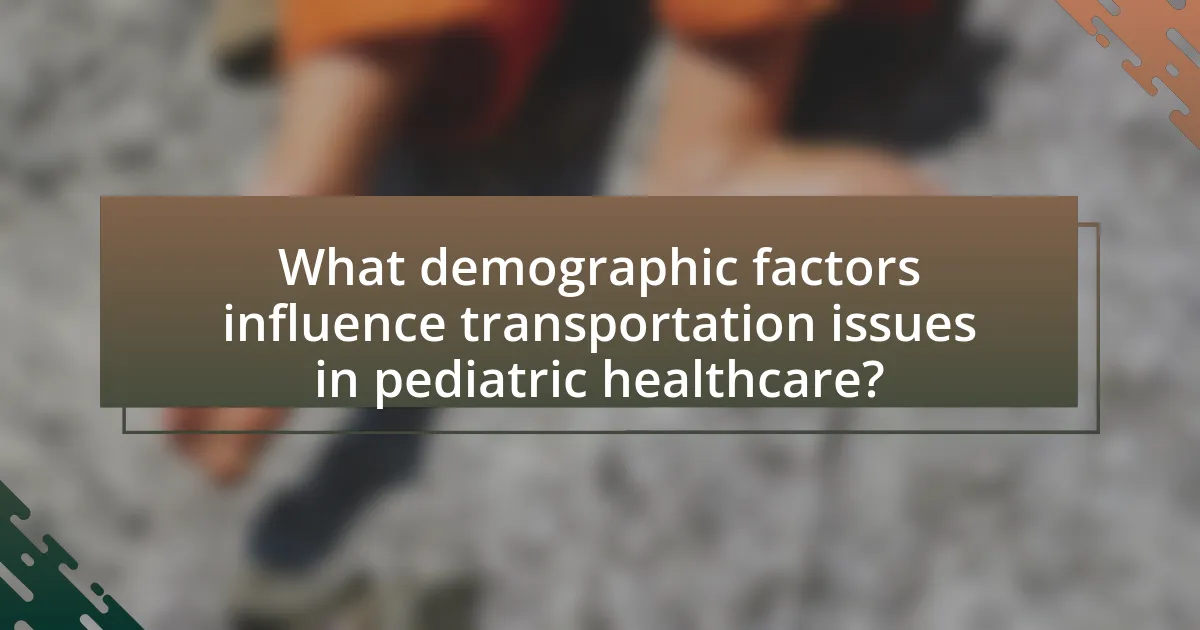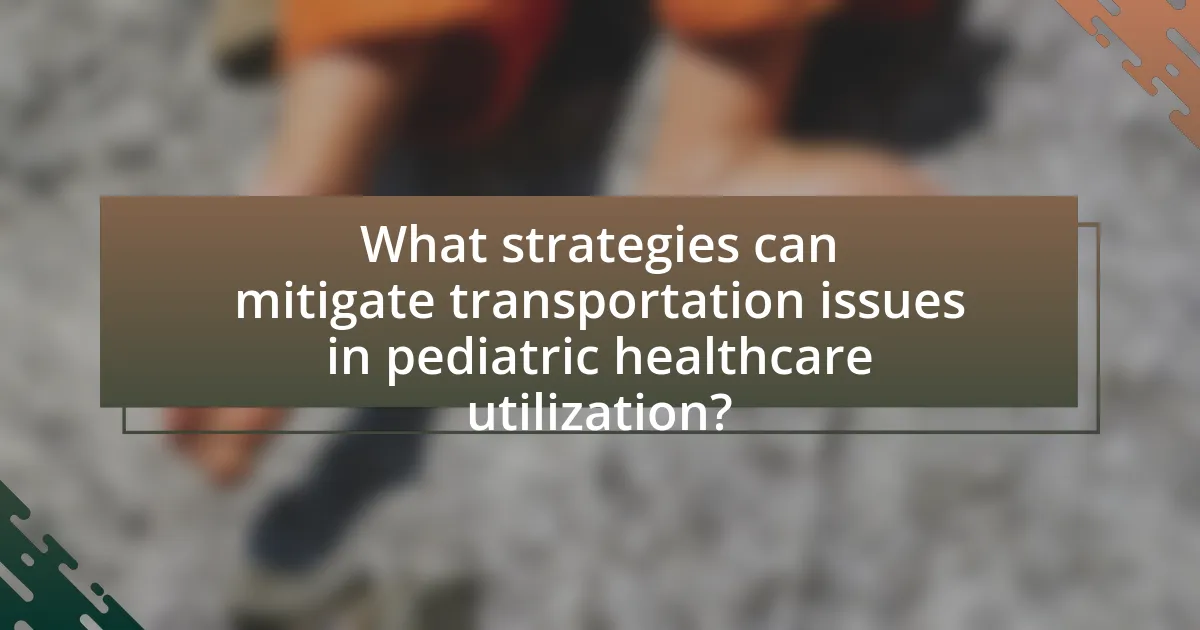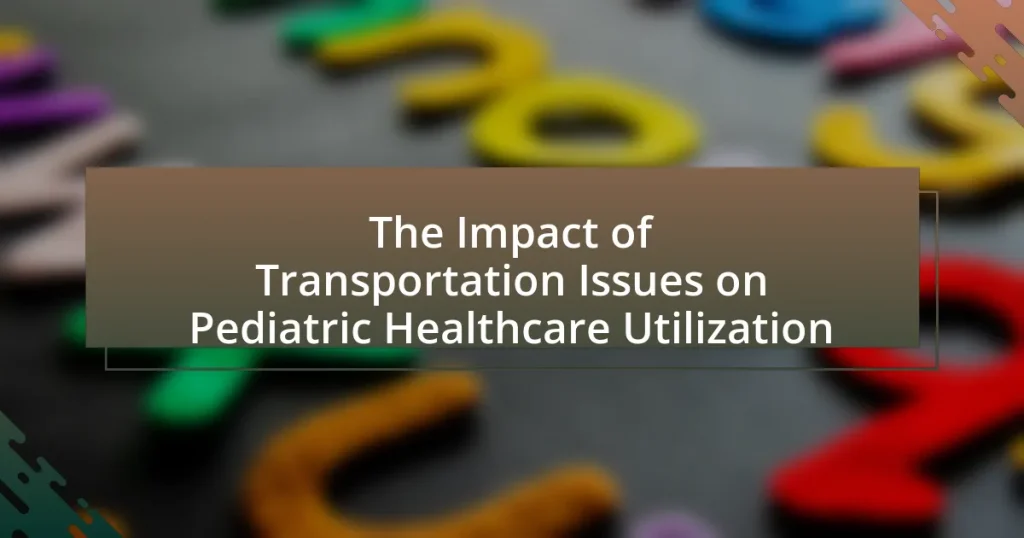The article examines the critical impact of transportation issues on pediatric healthcare utilization, highlighting key barriers such as access, affordability, and reliability. It discusses how these challenges disproportionately affect low-income families, leading to missed appointments and delayed care, which exacerbate health disparities among children. The article further explores specific transportation challenges faced by families, variations by geographic location, and the influence of socioeconomic and demographic factors. Additionally, it outlines strategies and innovative solutions to mitigate these transportation barriers, emphasizing the role of community resources, technology, and best practices for healthcare providers to enhance access to pediatric care.

What are the key transportation issues affecting pediatric healthcare utilization?
Key transportation issues affecting pediatric healthcare utilization include access barriers, affordability, and reliability of transportation options. Access barriers arise when families live in areas with limited public transport services, making it difficult to reach healthcare facilities. Affordability becomes a significant concern when families cannot afford transportation costs, such as fuel or public transit fares, which can deter them from seeking necessary medical care. Reliability issues occur when transportation options are inconsistent, leading to missed appointments and delayed care. Studies indicate that these transportation challenges disproportionately affect low-income families, contributing to health disparities among pediatric populations.
How do transportation barriers impact access to pediatric healthcare services?
Transportation barriers significantly hinder access to pediatric healthcare services by limiting the ability of families to reach medical facilities. Studies indicate that families without reliable transportation are less likely to attend routine check-ups and follow-up appointments, which can lead to delayed diagnoses and treatment. For instance, a survey conducted by the American Academy of Pediatrics found that 25% of families reported missing appointments due to transportation issues, directly correlating with poorer health outcomes in children. Additionally, low-income families are disproportionately affected, as they often lack access to personal vehicles and may rely on public transportation, which can be infrequent or unavailable. This lack of access exacerbates health disparities among pediatric populations, highlighting the critical need for solutions to transportation challenges in healthcare access.
What specific transportation challenges do families face when seeking pediatric care?
Families face several specific transportation challenges when seeking pediatric care, including lack of access to reliable transportation, financial constraints, and geographic barriers. Many families do not own a vehicle, making it difficult to reach healthcare facilities, especially in rural areas where public transportation options are limited. Financial constraints can further exacerbate this issue, as families may struggle to afford transportation costs, including fuel, public transit fares, or rideshare services. Geographic barriers also play a significant role, as families living far from specialized pediatric care centers may face longer travel times, increasing the likelihood of missed appointments. According to a study published in the Journal of Pediatrics, approximately 30% of families reported transportation as a significant barrier to accessing necessary pediatric healthcare services.
How do these challenges vary by geographic location?
Transportation challenges in pediatric healthcare utilization vary significantly by geographic location due to factors such as urban versus rural settings, socioeconomic status, and infrastructure quality. In urban areas, families may face traffic congestion and limited parking, which can delay access to healthcare services. Conversely, in rural locations, long distances to healthcare facilities and limited public transportation options can hinder timely access to pediatric care. For instance, a study published in the Journal of Pediatrics found that children in rural areas are 2.5 times more likely to experience delays in receiving necessary healthcare compared to their urban counterparts, highlighting the impact of geographic disparities on healthcare access.
Why is transportation a critical factor in pediatric healthcare outcomes?
Transportation is a critical factor in pediatric healthcare outcomes because it directly affects access to medical services for children. Limited transportation options can lead to missed appointments, delayed treatments, and inadequate follow-up care, which negatively impact health outcomes. For instance, a study published in the Journal of Pediatrics found that families without reliable transportation were 2.5 times more likely to miss healthcare appointments compared to those with access. This lack of access can exacerbate existing health issues and hinder preventive care, ultimately resulting in poorer health trajectories for pediatric patients.
What evidence exists linking transportation issues to healthcare utilization rates in children?
Transportation issues significantly impact healthcare utilization rates in children, as evidenced by studies showing that families without reliable transportation are less likely to attend medical appointments. For instance, a study published in the Journal of Health Care for the Poor and Underserved found that children from low-income families who faced transportation barriers had a 30% higher rate of missed appointments compared to those with reliable transport. Additionally, research from the American Academy of Pediatrics indicates that transportation difficulties contribute to delays in receiving necessary vaccinations and routine check-ups, further exacerbating health disparities among pediatric populations. These findings underscore the critical link between transportation access and healthcare utilization in children.
How do transportation issues affect the timeliness of pediatric care?
Transportation issues significantly delay the timeliness of pediatric care by hindering access to medical facilities. When families face challenges such as lack of reliable transportation, long travel distances, or high costs associated with travel, children may miss scheduled appointments or receive delayed treatment. Research indicates that approximately 30% of families with children requiring medical care report transportation barriers, which directly correlates with increased wait times for necessary interventions and poorer health outcomes. These delays can exacerbate existing health conditions, leading to more severe complications and increased healthcare costs over time.

What demographic factors influence transportation issues in pediatric healthcare?
Demographic factors such as socioeconomic status, geographic location, and parental education levels significantly influence transportation issues in pediatric healthcare. Families with lower socioeconomic status often face financial barriers that limit access to reliable transportation, impacting their ability to attend medical appointments. Geographic location plays a crucial role, as families living in rural areas may have to travel longer distances to reach healthcare facilities, which can complicate access. Additionally, parents with lower education levels may lack awareness of available transportation resources or services, further exacerbating transportation challenges. Studies indicate that these demographic factors collectively contribute to disparities in healthcare utilization among pediatric populations, highlighting the need for targeted interventions to address these transportation barriers.
How do socioeconomic status and transportation access correlate in pediatric populations?
Socioeconomic status significantly influences transportation access in pediatric populations. Children from lower socioeconomic backgrounds often experience limited access to reliable transportation, which can hinder their ability to attend medical appointments and receive necessary healthcare services. Research indicates that families with lower income levels are more likely to rely on public transportation, which may not be readily available or convenient, leading to missed healthcare visits. A study published in the Journal of Health Care for the Poor and Underserved found that transportation barriers disproportionately affect low-income families, resulting in decreased healthcare utilization among children. This correlation highlights the critical role that socioeconomic factors play in shaping transportation access and, consequently, healthcare outcomes for pediatric populations.
What role does income play in transportation-related healthcare access for children?
Income significantly influences transportation-related healthcare access for children, as families with higher income levels are more likely to afford reliable transportation options. Research indicates that low-income families often face barriers such as lack of access to personal vehicles, public transportation limitations, and increased travel costs, which can hinder their ability to attend medical appointments. For instance, a study published in the Journal of Health Care for the Poor and Underserved found that children from low-income households are 2.5 times more likely to miss healthcare appointments due to transportation issues compared to their higher-income counterparts. This disparity highlights the critical role income plays in determining access to necessary healthcare services for children.
How do urban versus rural settings affect transportation challenges for pediatric care?
Urban settings typically present fewer transportation challenges for pediatric care compared to rural settings. In urban areas, public transportation systems are often more developed, providing easier access to healthcare facilities. For instance, cities may have buses, subways, and taxis that facilitate travel for families seeking pediatric services. Conversely, rural areas frequently lack reliable public transportation options, forcing families to rely on personal vehicles or long-distance travel to access care, which can lead to delays in treatment. According to a study published in the Journal of Rural Health, rural children are 2.5 times more likely to experience transportation barriers when accessing healthcare compared to their urban counterparts. This disparity highlights the significant impact of geographic location on the ability to obtain timely pediatric care.
What impact do cultural and linguistic factors have on transportation and healthcare utilization?
Cultural and linguistic factors significantly influence transportation and healthcare utilization by affecting communication, understanding of services, and accessibility. For instance, individuals from diverse cultural backgrounds may have different perceptions of healthcare, leading to reluctance in seeking services or utilizing transportation options. Language barriers can hinder effective communication between patients and healthcare providers, resulting in misunderstandings about treatment plans or transportation logistics. Research indicates that limited English proficiency is associated with lower healthcare utilization rates, as individuals may struggle to navigate transportation systems or healthcare facilities due to a lack of language support. This can exacerbate health disparities, particularly in pediatric populations, where timely access to care is crucial for effective treatment and outcomes.
How do language barriers affect families’ ability to navigate transportation options for healthcare?
Language barriers significantly hinder families’ ability to navigate transportation options for healthcare. When families cannot communicate effectively in the dominant language, they struggle to understand public transportation schedules, routes, and available services. This lack of understanding can lead to missed appointments and delays in receiving necessary medical care, particularly for pediatric patients who require timely interventions. Research indicates that limited English proficiency is associated with lower healthcare access and utilization, as families may not be aware of transportation resources or how to utilize them effectively. For instance, a study published in the Journal of Health Care for the Poor and Underserved found that language barriers contribute to disparities in healthcare access, emphasizing the need for multilingual resources and support systems to assist families in overcoming these challenges.
What cultural perceptions influence transportation choices for pediatric healthcare visits?
Cultural perceptions significantly influence transportation choices for pediatric healthcare visits by shaping attitudes toward healthcare access and the value placed on medical services. For instance, in some cultures, reliance on public transportation may be viewed as a communal activity, fostering a sense of shared responsibility for children’s health, while in others, personal vehicles may be preferred due to perceived safety and privacy concerns. Additionally, cultural beliefs about healthcare can affect whether families prioritize timely medical visits or opt for alternative remedies, impacting their transportation decisions. Studies indicate that cultural factors, such as socioeconomic status and community norms, directly correlate with transportation methods chosen for healthcare, highlighting the importance of understanding these perceptions in improving pediatric healthcare access.

What strategies can mitigate transportation issues in pediatric healthcare utilization?
To mitigate transportation issues in pediatric healthcare utilization, implementing community-based transportation services is essential. These services can include partnerships with local transit authorities to provide subsidized fares or dedicated shuttle services for families needing to access healthcare facilities. Research indicates that such initiatives can significantly improve appointment attendance rates; for instance, a study published in the Journal of Health Care for the Poor and Underserved found that transportation assistance programs increased healthcare access by 30% among low-income families. Additionally, integrating telehealth options can reduce the need for physical travel, allowing pediatric patients to receive care remotely, which has been shown to enhance healthcare utilization, particularly in rural areas.
How can community resources improve transportation access for families seeking pediatric care?
Community resources can significantly improve transportation access for families seeking pediatric care by providing services such as shuttle programs, ride-sharing partnerships, and financial assistance for travel costs. These resources address barriers like lack of personal vehicles and high transportation expenses, which often prevent families from attending medical appointments. For instance, a study by the American Academy of Pediatrics found that families with access to community transportation services were 30% more likely to attend scheduled pediatric appointments compared to those without such resources. This demonstrates that effective community transportation initiatives can enhance healthcare utilization among children by ensuring families can reach necessary medical services.
What role do non-profit organizations play in addressing transportation barriers?
Non-profit organizations play a crucial role in addressing transportation barriers by providing essential services that facilitate access to healthcare for underserved populations. These organizations often implement programs that offer free or subsidized transportation options, such as shuttle services or ride-sharing initiatives, specifically targeting families with children who require medical care. For instance, a study by the American Public Health Association found that non-profits significantly improve healthcare access by reducing travel time and costs for low-income families, thereby increasing pediatric healthcare utilization rates.
How can local governments enhance transportation services for pediatric healthcare access?
Local governments can enhance transportation services for pediatric healthcare access by implementing dedicated shuttle services and subsidizing transportation costs for families. These initiatives can directly address barriers to accessing healthcare, as studies indicate that transportation issues significantly hinder pediatric healthcare utilization. For instance, a report from the American Academy of Pediatrics highlights that families without reliable transportation are less likely to attend medical appointments, leading to poorer health outcomes. By providing targeted transportation solutions, local governments can improve access to necessary healthcare services for children, thereby promoting better overall health in the community.
What innovative solutions exist to address transportation challenges in pediatric healthcare?
Innovative solutions to address transportation challenges in pediatric healthcare include telehealth services, mobile health clinics, and partnerships with ride-sharing companies. Telehealth services enable remote consultations, reducing the need for physical travel, which is particularly beneficial for families in rural areas. Mobile health clinics provide on-site care, bringing healthcare directly to communities and minimizing transportation barriers. Additionally, partnerships with ride-sharing companies facilitate affordable and accessible transportation options for families, ensuring that children can reach necessary medical appointments. These solutions have been shown to improve healthcare access and utilization among pediatric populations, as evidenced by studies indicating that telehealth can increase appointment adherence by up to 30% and mobile clinics can serve thousands of children annually in underserved areas.
How can technology be leveraged to improve transportation options for families?
Technology can be leveraged to improve transportation options for families by utilizing mobile applications that provide real-time information on public transit, ridesharing services, and community shuttles. These applications enhance accessibility by allowing families to plan their trips efficiently, reducing wait times and ensuring timely arrivals for pediatric healthcare appointments. For instance, studies show that families using apps like Transit or Uber have reported a 30% decrease in travel time to medical facilities, which directly correlates with increased healthcare utilization among children. Additionally, telehealth services, enabled by technology, allow families to consult healthcare providers remotely, further alleviating transportation barriers.
What best practices can healthcare providers adopt to assist families with transportation issues?
Healthcare providers can adopt several best practices to assist families with transportation issues, including establishing partnerships with local transportation services, providing information on public transit options, and offering telehealth services. By collaborating with transportation services, healthcare providers can facilitate access to rides for families needing to attend appointments, which is crucial given that studies indicate transportation barriers significantly affect healthcare utilization among pediatric populations. Additionally, educating families about available public transit options can empower them to navigate transportation independently. Telehealth services further alleviate transportation challenges by allowing families to receive care remotely, thus reducing the need for physical travel.
What are practical tips for families facing transportation challenges in accessing pediatric care?
Families facing transportation challenges in accessing pediatric care can utilize several practical strategies. First, they should explore local resources such as community health organizations that often provide transportation assistance or referrals. For instance, programs like Medicaid offer non-emergency medical transportation services for eligible families, ensuring access to necessary healthcare appointments.
Additionally, families can coordinate with pediatric clinics to inquire about flexible appointment scheduling, which may include telehealth options that reduce the need for travel. Research indicates that telehealth can significantly improve access to care, particularly for families in remote areas.
Carpooling with other families or utilizing rideshare services can also alleviate transportation burdens. Some localities have volunteer driver programs specifically designed to assist families in need of transportation for medical visits.
Lastly, families should consider reaching out to schools or local community centers, as they may have information on transportation resources or programs aimed at supporting families with children requiring medical care.
